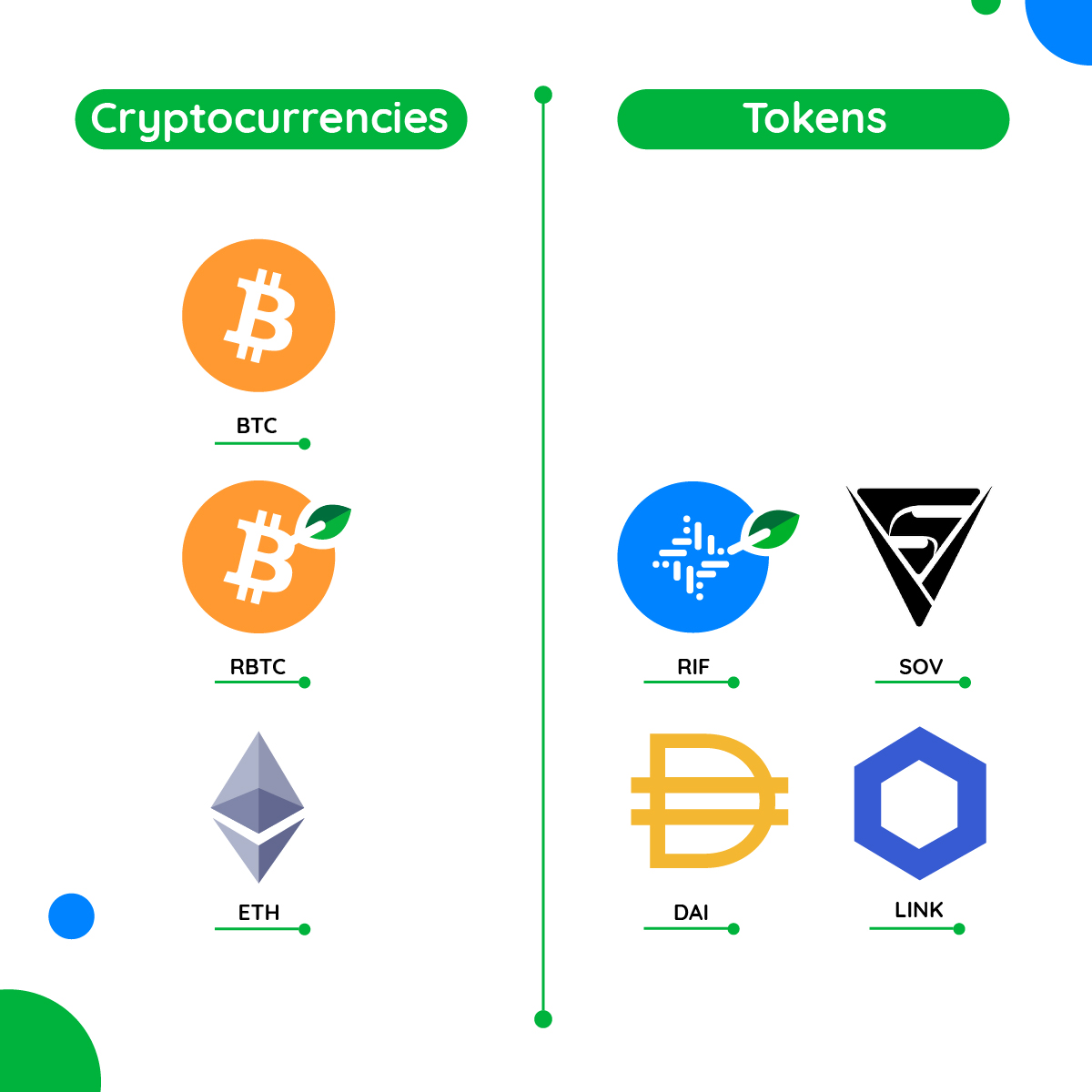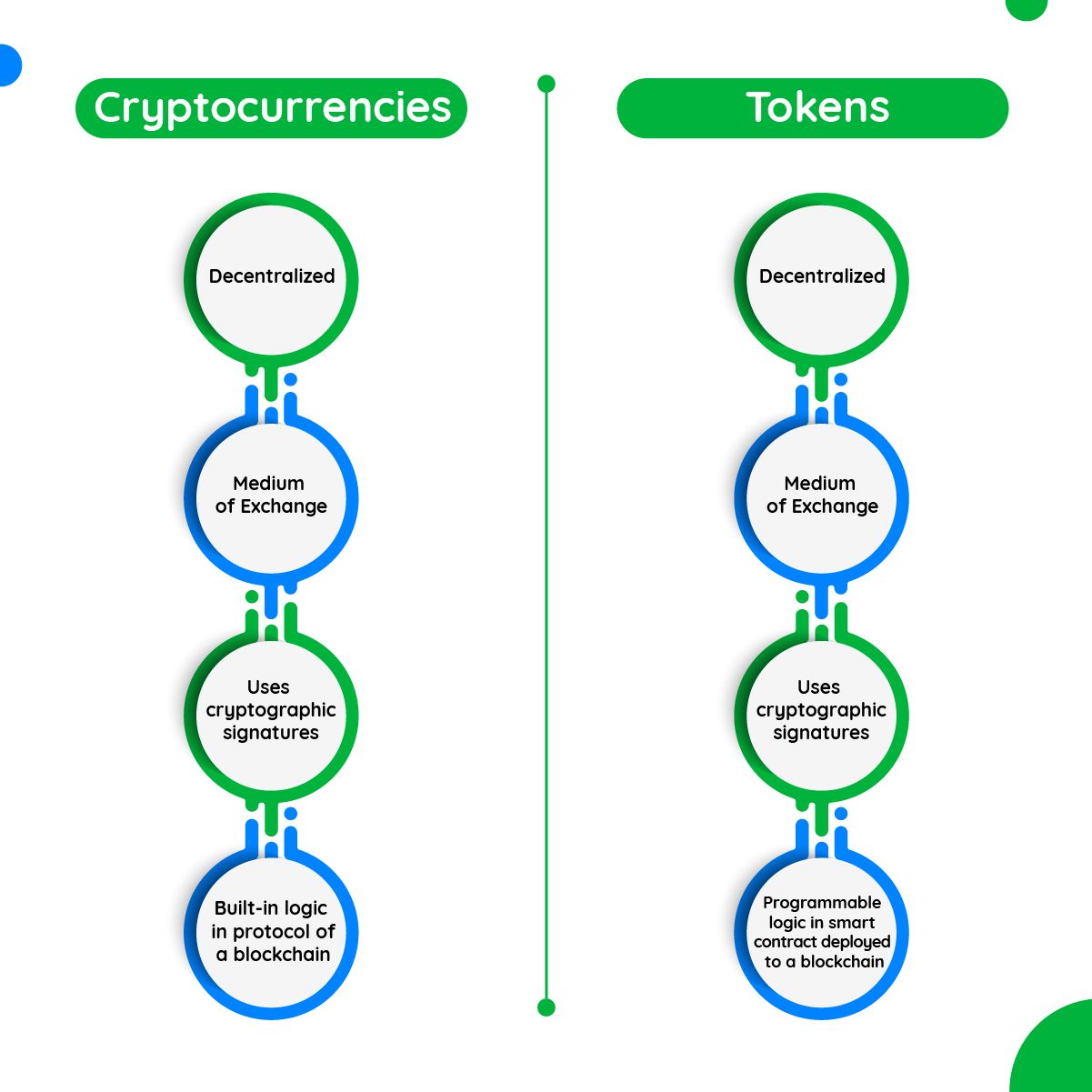CRYPTO COIN VS CRYPTO TOKEN
What is a crypto coin?
Cryptocurrency coins are generally used in the same way as a real-life coin is –as money. These coins help in paying for different goods and services. You can think of coins like Bitcoin, Litecoin, and Monero just like the coins in your wallet or piggy bank.
These “cash only” coins are used:
- To transfer money (you can give and receive value using them)
- As a store of value (they can be saved and later swapped for something useful)
- As a unit of account (you can price goods or services in them)
A crypto coin operates on the blockchain. The network keeps track of all the transactions that involve the native crypto coin. In many cases, crypto coins are not only used to pay transaction fees through the network but it is also used to incentivize users to keep the cryptocurrency network secure.
A coin is defined by the following characteristics:
-
Operates on its blockchain. A blockchain keeps track of all transactions that involve its native crypto coin.
When you pay someone with Ethereum, the receipt goes to the Ethereum blockchain. If the same person pays you back later with Bitcoin, the receipt goes to the Bitcoin blockchain. Each transaction is protected by encryption and is accessible by any member of the network.
-
Acts as money. Bitcoin was created for the sole purpose of replacing traditional money. The paradoxical appeal of transparency and anonymity inspired the creation of other coins, including ETH, NEO, and Litecoin.
You can purchase merchandise and services from many major corporations today, such as Amazon, Microsoft, and Tesla, using crypto coins. Bitcoin has recently become an official currency of El Salvador alongside the US dollar.
-
Can be mined. You can earn crypto coins in two ways. One is through traditional mining on the Proof of Work system. Bitcoin hunters employ this method to boost their earnings. The problem with this is that there aren't that many Bitcoins left to mine, so the process becomes more arduous every day.
The other method is Proof of Stake, which is a more modern approach to earning coins. It's lighter on energy consumption and easier to do. Cardano is one of the biggest coins that adopt this system.
Examples of Cryptocurrency coins
ALTCOINS
An Altcoin is an alternative digital currency to Bitcoin. It actually refers to a group of cryptocurrencies, ultimately all the cryptocurrencies other than Bitcoin.
Altcoins work on the same core principles as bitcoins. They differ from bitcoin in their mining process called proof of stake where the mining power of an investor is directly proportional to the number of coins they have. They experience a spike in their values.(volatile)
Examples of Altcoins
- Ethereum (ETH)
- Solana (SOL)
- Litecoin (LTC)
- Lisk (LSK)
- Monacoin (MONA)
- Stellar Lumens (XLM)
- Basic Attention Token (BAT)
- Tezos (XTZ)
- Polkadot (DOT)
STABLECOINS
Stablecoins are digital representations of fiat currencies whose price is tethered to a cryptocurrency or fiat money or for trading commodities like valuable metals. THey are not that prone to experience a spike in their values. stablecoins They fall into three groups:
-
Fiat-collateralized: The crypto-currency is backed by fiat currency. Examples are Tether (USDT) and the Gemini Dollar (GUSD). real asset backed
-
Crypto-collateralized: The crypto-currency is backed by a crypto-currency. An example is DAI. crypto-collateralized
-
Non-collateralized stablecoins rely on a smart contract to buy/sell the stablecoin in order to keep the price constant.These type of stablecoins do not need collateral, and their value is regulated by the supply. non-collateralized
NOTE
Several stablecoins are actually not coins, but tokens.
Two examples of stablecoins are:
Two examples for “stable tokens” are:
Both are ERC20 tokens on the Ethereum blockchain.
![]()
TOKENS
What is a cryptocurrency token?
A crypto token is a virtual currency token or a denomination of a cryptocurrency but they form a different digital asset category. Like coins, crypto tokens can also hold value and can be exchanged, but they generally represent physical assets, a utility, or a service. Some tokens even represent real estate and art.The best-known example of this is the non-fungible token or NFT.
tokenization - process of creating tokens and assigning value to them.
Tokens rely on smart contracts for transactions. Smart contracts facilitate trades or payments between users. Each blockchain uses its smart contract. For example, Ethereum uses ERC-20, and NEO uses Nep-5. Unlike coins, tokens do not have their blockchain. Instead, they operate on other crypto coins' blockchains, such as Ethereum.
Illustration
When one owns a car, they are given a title. This title is a token. When you sell the car, you transfer the value of the title to the buyer. However, you cannot use the title to buy anything else, it just represents the car value and ownership.
TOKEN TYPES
Utility Tokens
They are created by businesses. They give the owner the right to use that company’s product or service in the future.
This makes utility tokens a store of value. They function like digital coins with restricted functionality. They are consumer or incentive tokens which are sold as part of a fund development and can be used as part of a network or project e.g. loyalty programs.
Security Tokens
Security tokens represent a tradable investment or asset. The shares of a company can be tokenized, as can the deed to real estate or a car.
As investments, tokens are regulated by government agencies. In theory, this makes their owners less vulnerable to hacking and fraud. Ownership of a security token is verified through a record of its existence on a blockchain.
![]()
Non-Fungible Tokens(NFT)
NFTs are unique cryptographic tokens that exist on a blockchain and cannot be replicated. NFTs can represent real-world items like artwork and real estate. NFTs can also function to represent individuals' identities, property rights, and more.
NFTs evolved from the ERC-721 standard. Developed by some of the same people responsible for the ERC-20 smart contract, ERC-721 defines the minimum interface—ownership details, security, and metadata—required for the exchange and distribution of gaming tokens. The ERC-1155 standard takes the concept further by reducing the transaction and storage costs required for NFTs and batching multiple types of non-fungible tokens into a single contract.
Differences
The difference between tokens and coins is what they represent. While crypto coins are essentially digital versions of money, tokens can stand for assets or deeds.
You can buy tokens with coins, but some tokens can carry more value than any of them. For example, a company's share. However, since there are usually restrictions to where you can spend a token, it doesn't have the liquidity a coin offers.
Simply put, a token represents what you own, while a coin denotes what you're capable of owning.


REFERENCES
https://www.ndtv.com/business/crypto-assets-whats-the-difference-between-coins-and-tokens-2714817
https://blog.liquid.com/coin-vs-token
https://www.investopedia.com/terms/c/crypto-token.asp
https://www.bitdegree.org/crypto/tutorials/token-vs-coin
https://developers.rsk.co/guides/get-crypto-on-rsk/cryptocurrency-vs-token/
https://www.analyticsinsight.net/exploring-the-difference-between-crypto-coins-and-crypto-tokens/
https://www.coinbase.com/learn/crypto-basics/what-is-a-token
https://cryptopotato.com/security-vs-utility-tokens-the-complete-guide/
https://www.gobankingrates.com/investing/crypto/cypto-coin-vs-token/
https://askanydifference.com/difference-between-stablecoins-and-altcoins/
https://www.theverge.com/22310188/nft-explainer-what-is-blockchain-crypto-art-faq
https://www.investopedia.com/non-fungible-tokens-nft-5115211